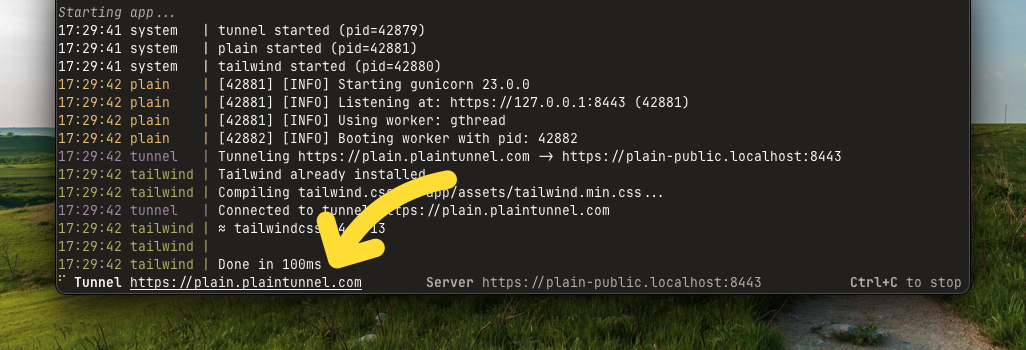1# plain.tunnel 2 3**Connecttoyourlocaldevelopmentserverremotely.** 4 5ThePlainTunnelisahostedservice,like[ngrok](https://ngrok.com/) or [Cloudflare Tunnel](https://developers.cloudflare.com/cloudflare-one/connections/connect-networks/), that is specifically designed to work with Plain and provide the minimum set of features you need to get your local development server connected to the internet. It will provision a subdomain of plaintunnel.com for you, and forward traffic to your local development server. 6 7Thisisespeciallyusefulfortestingwebhooks,doingmobilestylingonarealdevice,ortemporarilysharingyourlocaldevelopmentURLwithsomeone. 8 9_Note:Inthefuturethiswilllikelyrequireasmallsubscriptiontousecustomsubdomains(vsrandomlygeneratedones)._1011## Usage1213Thesimplestwaytouse`plain.tunnel`istoinstallitfromPyPI(`uvaddplain.tunnel--dev`),thenaddittoyour`plain.dev`configuration.1415```toml16[tool.plain.dev.run]17tunnel={cmd="plain tunnel $PLAIN_DEV_URL --subdomain myappname --quiet"}18```1920ToshowatunnelURL(whetheryouareusing`plain.tunnel`ornot),youcanadd`PLAIN_DEV_TUNNEL_URL`toyourlocal`.env`file.2122```bash23PLAIN_DEV_TUNNEL_URL=https://myappname.plaintunnel.com24```25262728Dependingonyoursetup,youmayneedtoaddyourtunneltothe`settings.ALLOWED_HOSTS`,whichcanbedonein`settings.py`orinyourdev`.env`.2930```bash31PLAIN_ALLOWED_HOSTS='["*"]'32```3334## CLI3536Touse`plain.tunnel`manually,youcanusethe`plaintunnel`command(orevenuseitasaone-offwithsomethinglike`uvxplain-tunnel`).3738```console39plaintunnelhttps://app.localhost:844340```